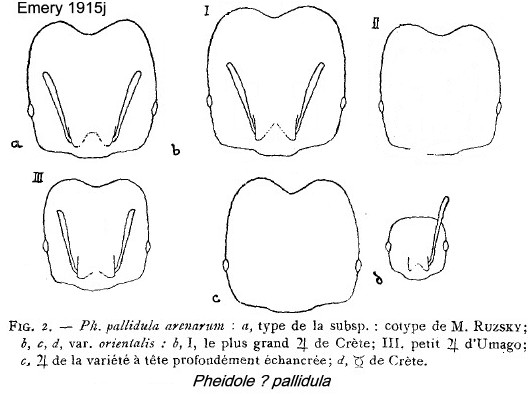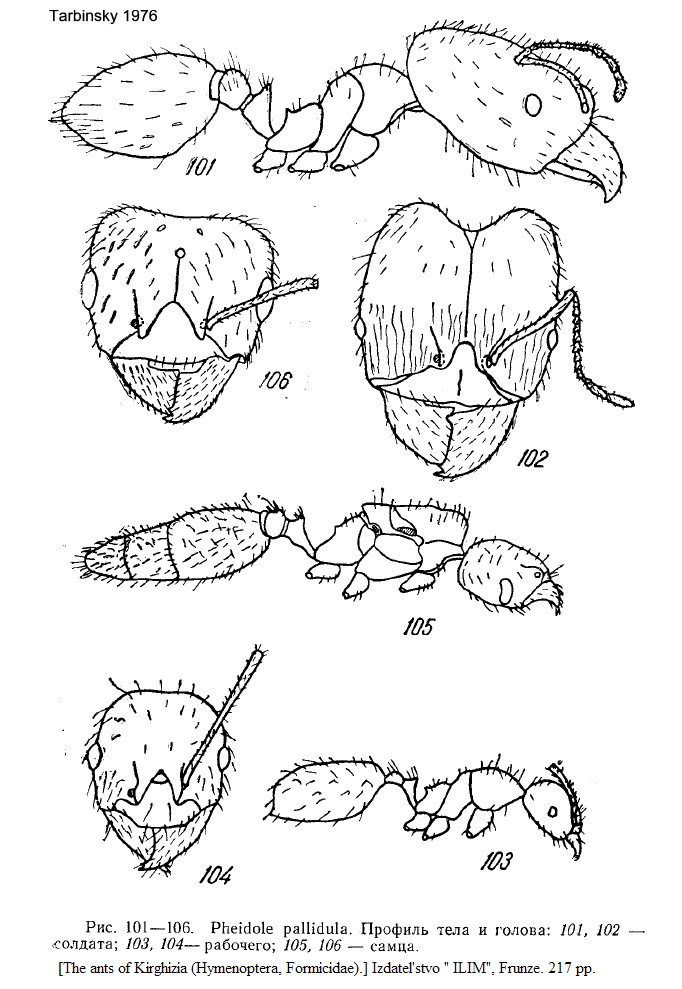Pheidole arenarum Ruzsky - revived status
 MAJOR MAJOR  MINOR MINOR  Type location Turkestan
(Pheidole pallidula var arenarum nov. var., Ruzsky,
1905b: 647,
soldier, worker & male [unavailable in HNS, but translated in
Emery, 1915j]; Karavaiev, 1926b: 106, queen; subspecies in Emery
(1915j: 226; raised to species by Collingwood (1961a: 64, 1961b: 289);
placed as a junior synonym of pallidula by Atanassov &
Dlussky (1992: 123) - no images on Antweb (November 2014) Type location Turkestan
(Pheidole pallidula var arenarum nov. var., Ruzsky,
1905b: 647,
soldier, worker & male [unavailable in HNS, but translated in
Emery, 1915j]; Karavaiev, 1926b: 106, queen; subspecies in Emery
(1915j: 226; raised to species by Collingwood (1961a: 64, 1961b: 289);
placed as a junior synonym of pallidula by Atanassov &
Dlussky (1992: 123) - no images on Antweb (November 2014)
koshewnikovi (Pheidole
pallidula koshewniovi nov. subsp., Ruzsky, 1905b: 648, soldier
&
worker) from Russia - no images on Antweb (November 2014)
We have removed Pheidole
orientalis (Emery, 1915j: 230, the pallidula of Ruzsky,
1905; Müller, 1923: 69, soldier & worker) to a separate
species status.
|
 Ruszky's (1905) description of orientalis (as pallidula
and arenarum is at Ruszky's (1905) description of orientalis (as pallidula
and arenarum is at  . Emery (1915j) gave an illustrated note on
orientalis and arenarum, this is at . Emery (1915j) gave an illustrated note on
orientalis and arenarum, this is at  . Emery (1915j) gave a note on koshewnikovi,
this is at . Emery (1915j) gave a note on koshewnikovi,
this is at  . .
Mayr (1880: 38) wrote in his note on "Pheidole pusilla"
how he regarded P. pallidula as known from southern Europe and
Algeria, whereas P. pusilla was cosmopolitan into the south
European peninsulas, with soldiers that had long propodeal spines being
P. pusilla; the note is at  . .
Emery (1915j: 229) emphasised that the type form was not
found in Asia, and Ruszky was wrong, what Ruszky described as pallidula
was an undescribed form. Emery called that orientalis and
regarded it as very close to the Ruszky subspecies arenarum. He
noted also the identity of "Pheidole pusilla" of Mayr (1877,
1880, Fedtschenko voyage to Turkestan) and megacephalo-pallidula
of Emery & Forel (1979) were probably of this eastern form. Emery
had not seen those reported from Egypt or from the Balkans.
Emery (1915j) noted the minor of arenarum and
its variety orientalis had the head widely truncate
posteriorly, with more rounded posterior angles; the scape surpassed
the occipital border by one-third of its own length, e.g. much more
than in the type form minor. The pedicel was like the type but
sometimes the propodeal spines were longer. Dark brown or chestnut
brown; the major head was lighter, brownish yellow-red.
In a footnote, Emery gave a translation of Ruzky's
(1905b) description of koshewnikovi - this (from the French)
was
MAJOR - with the head wider than Ph. pallidula or megacephala
and is another form; it is narrowed both anteriorly and posteriorly, a
little more behind, the occiput is narrower and more deeply incised;
the scape is weakly dilated apically but less so than pallidula;
the anterior surface of the mandibles is not distinctly striated but
solely punctate, the mandible has striations close to the base and on
the exterior border. The longitudinal rugae on the anterior of thehead
are straight and regular with equal intervals, between the eyes the
rugae are very feeble and fine (with pallidula and megacephala
these rugae are much strnger and raised. The propodeal spines are more
raised and wider than on pallidula. The sculpture and shape of
the alitrunk is as pallidula but the mesonotum is less convex.
Alitrunk and pedicel brown; head brown red; border of mandibles and
clypeus blackish; gaster dark brown; appendages light brown. Pilosity
as pallidula; TL 4-4.5 mm.
Emery had examined a cotype and noted the differences from the type pallidula;
he also stated the minor did not differ from the that of the subspecies
arenarum.
|
 Collingwood
(1961a: 64), reporting ants from Afghanistan, had - Collingwood
(1961a: 64), reporting ants from Afghanistan, had -
Pheidole arenarum Ruzsky, 1905.
(P. pallidula var. arenarum Ruzsky, 1905)
This was first described as a variety of P. pallidula L. The
species is distinguished by the marked prolongation of the head behind
the eyes and the much deeper emargination between the occipital lobes.
The queens have the body pale ochreous except for the thoracic sutures,
the clypeal border and a patch on the occipital region which are
darker. Range. Central Asia.
Pizarski (1967: 385) listed many findings of Pheidole
pallidula arenarum Ruzsky, 1905, from Afghanistan and gave the
overall range as the mountains of Central Asia, the Kopet Dag, Hindu
Kush and Tian-Chan.
Tarbinsky (1976) gave illustrated descriptions in
Russian of the type form (?) and koshnewnikovi from Kirghizia;
these are on  . .
|
New descriptions
MAJOR. TL 3.4-3.9 mm; CI 85 SI 55 OI 12
Head in full face view elongated cordate with a deeply impressed occiput
Mandibles large and heavy, weak striations over full length of upper
surface
Clypeus shiny with a distinct but narrow median longitudinal carina and
very weak lateral carinae; anterior margin sinuous with very shallow
median impression
Frontal carinae moderately long, reaching back behind the level of the
eyes and weakly divergent
Antennae with both scapes and funiculi slender but quite long;
funiculus segments 2-7 all slightly longer than they are wide; the
apical segment is about as long as the two pre-apical segments together
Eye fairly small and weakly ovoid circular (10 facets long X 10 wide);
set 1.8 X its own length back from the lateral margin of the clypeus
Hypostoma with a black border and solely paired large lateral teeth
Underside of head weak semicircular rugulation and moderately shiny
Alitrunk with promesonotum profile overall smoothly convex without any
tubercles; from above the promesonotum is near circular but is weakly
angular at the widest point; the propodeum profile is weakly convex
with very small triangular teeth; the dorsum of the propodeum has a
shallow but distinct longitudinal impression but this does not narrow
from front to back; the propodeum dorsum at the base of the teeth is
only 0.33 X the maximum width of the promesonotum
Petiole in profile with the posterior faced vertical, the upper margin
narrowly rounded and medially impressed
Postpetiole fairly small, seen from above hexagonal but wider than
long, with failry sharp lateral apices; in profile ovoid domed above
and flat below
Gaster distinctly smaller than the head and quite narrow with a
straight anterior margin
Erect pilosity quite long, fine and quite abundant; pubescence short,
adpressed but quite abundant
Overall appearance polished and shiny; sculpturation on head confined
to quite coarse striations on anterior half both frontally and
laterally; mesonotum and propodeum with very little sculpturation
General colour red-brown, with the gaster and anterior head darker; the
antennae and legs are quite bright orange.
|
MINOR. TL ca 2.7 mm; CI 87 SI 120 OI 28 MI 25 PI
68
Head with sides strongly convex, posterior angles rounded in a near
continuous curve with the convex occiput; with a very narrow nuchal
collar
Mandibles moderately long, with quite coarse teeth on the masticatory
margin; and with two large apical teeth
Anterior margin of clypeus very weakly concave medially, without a
median or any other carinae; with only four conspicuous forward facing
long hairs
Frontal carinae short but very slightly wider apart at posterior limit;
set quite far apart, about 0.4 the width of the head at the level of
the antennal insertions; the frontal area (notch) is distinctly and
quite deeply impressed
Scapes long and slender, thickening very slightly in apical one-third,
surpassing the occiput by about 1/6 of their length; funiculus about
50% longer than scape; the 3-segmented club has the apical segment
almsot twice as long as the pre-apical two together; the pre-apical
segments are almost as wide as they are as long
The eye is quite small, slightly ovoid longitudinally and only weakly
convex; the anteriormost point is 1.3 X its own length back from the
anterior point of the genae
Alitrunk profile with promesonotum evenly and strongly convex,from
above the pronotum is a distinctive circular shape; the pro-mesonotal
suture is just visible laterally and not interrupting the profile; the
metanotal groove is distinct but shallowly impressed both dorsally and
laterally; the propodeum has the dorsum convex in profile, lacking
lateral margination and with only minute teeth, the declivity is
slightly concave
The petiole has a fairly short pedicel and a low triangular profile,
with the apex angular and a very short posterior face; the postpetiole
has a low profile domed above and flat below; seen from above it is
about twice as wide as the petiole and weakly hexagonal, with distinct
apical points bearing a laterally pointing hair
The gaster is globular viewed laterally and from above broadens sharply
from a narrow, straight anterior margin
The legs are relatively long with moderately swollen femora
The whole of the head, body, antennae and legs bear long, fine erect
hairs
Polished shiny with very little sculpturation other than very fine
longitudinal striations on the lateral head and quite marked
puncturation on the lateral mesonotum, in contrast the lateral
propodeum is almost unsculptured
Overall red-yellow-brown; somewhat lighter on the alitrunkm appendages
and pedicel.
Specimens examined - from Turkey - 2 majors and 2 minors
|
Oxford University Museum
specimens
Pheidole arenarum
B Taylor det.
|
Turkey
David King
|
2.vi.2007
Belek
36°50'29" N
31°07'20" E
|
elev 6 m asl
|
4
|
 |
|
Majors
|
 The photomontage is of majors from Turkey, Belek; collector David
King. The photomontage is of majors from Turkey, Belek; collector David
King.
|
 The photomontage is of a second major from Turkey,
Belek; collector
David King. The photomontage is of a second major from Turkey,
Belek; collector
David King.
|
Minors
|
 The
photomontage is of a minor from Turkey, Belek; collector David King. The
photomontage is of a minor from Turkey, Belek; collector David King.
|
|